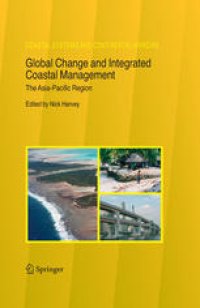
Ebook: Global Change and Integrated Coastal Management: The Asia-Pacific Region
- Tags: Geosciences general, Climate Change, Environmental Management, Physical Geography
- Series: Coastal Systems and Continental Margins 10
- Year: 2006
- Publisher: Springer Netherlands
- Edition: 1
- Language: English
- pdf
Most of the world’s population lives close to the coast and is highly dependent on coastal resources, which are being exploited at unsustainable rates. These resources are being subject to further pressures associated with population increase and the globalization of coastal resource demand. This is particularly so for the Asia-Pacific region which contains almost two thirds of the world’s population and most of the world’s coastal megacities. The region has globally important atmospheric and oceanic phenomena, which affect world climate such as the Asian Monsoon and the El-Niño Southern Oscillation phenomena. The Asia-Pacific region also has highly significant marine diversity but over the last few decades, coastal resources such as mangroves, coral reefs and fisheries have experienced large-scale depletion. The need to find appropriate management solutions to these and other coastal issues is made more complex by the need to take account of international scientific predictions for global climate change and sea-level rise which will further impact on these coasts. The idea for this book arose from a meeting of coastal scientists in Kobe, Japan in May 2003. The meeting was organized by the Asia-Pacific Network for Global Change Research (APN), an inter-governmental network, comprising 21 member countries, for the promotion of global change research and links between science and policy making in the region.
This book focuses on the potential impacts of global change on coastal environments in the Asia-Pacific region. The region is significant because phenomena such as the Asian Monsoon and the El Niño—Southern Oscillation (ENSO) phenomena, affect the world climate; it has diverse marine and terrestrial ecosystems, including the world largest areas of coral reefs and mangroves; it has almost two-thirds of the world’s total human population; and its economic growth rate is the highest of any region in the world. The book identifies important global change issues which will be relevant for the future management of coastal environments in the Asia-Pacific region. The most important of these is global warming and accelerated sea-level rise. The potential impacts from this are compounded by current issues such as unsustainable use of coastal resources; coastal impacts from poor catchment management; population increase and urbanisation pressure; coastal resource and development pressure on rural coasts. The book addresses methods for tackling these issues such as ‘integrated coastal management’ and the need to recognize the diversity of coastal management practices in the Asia-Pacific region. The book is written by international coastal experts from the region who have identified key directions for future global change research that will be of relevance for coastal management in the Asia-Pacific region.